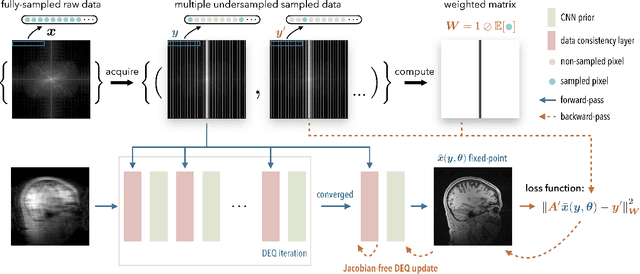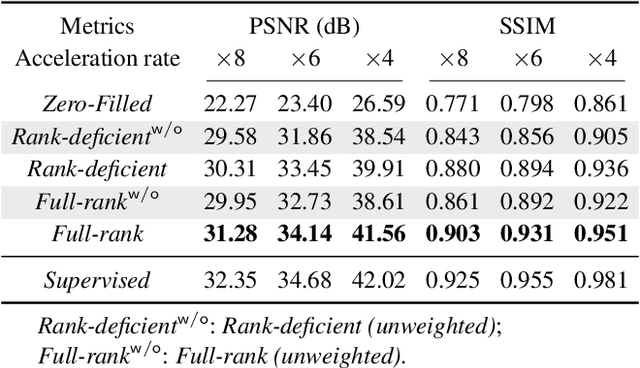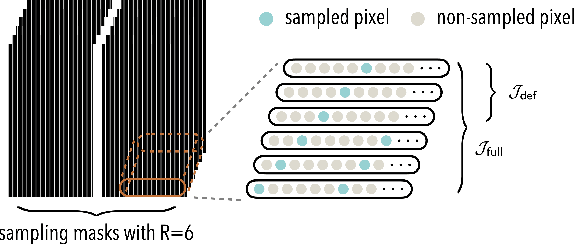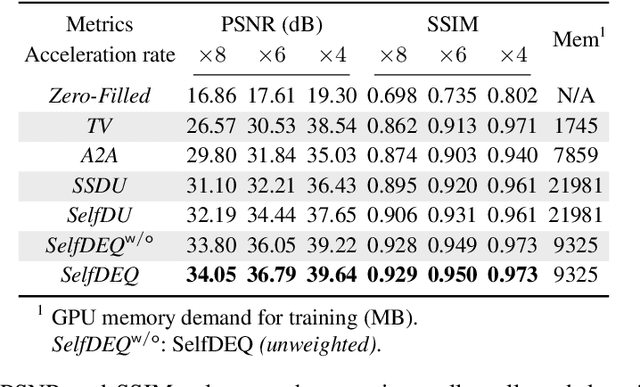Cihat Eldeniz
Self-Supervised Deep Equilibrium Models for Inverse Problems with Theoretical Guarantees
Oct 07, 2022



Abstract:Deep equilibrium models (DEQ) have emerged as a powerful alternative to deep unfolding (DU) for image reconstruction. DEQ models-implicit neural networks with effectively infinite number of layers-were shown to achieve state-of-the-art image reconstruction without the memory complexity associated with DU. While the performance of DEQ has been widely investigated, the existing work has primarily focused on the settings where groundtruth data is available for training. We present self-supervised deep equilibrium model (SelfDEQ) as the first self-supervised reconstruction framework for training model-based implicit networks from undersampled and noisy MRI measurements. Our theoretical results show that SelfDEQ can compensate for unbalanced sampling across multiple acquisitions and match the performance of fully supervised DEQ. Our numerical results on in-vivo MRI data show that SelfDEQ leads to state-of-the-art performance using only undersampled and noisy training data.
SPICE: Self-Supervised Learning for MRI with Automatic Coil Sensitivity Estimation
Oct 05, 2022



Abstract:Deep model-based architectures (DMBAs) integrating physical measurement models and learned image regularizers are widely used in parallel magnetic resonance imaging (PMRI). Traditional DMBAs for PMRI rely on pre-estimated coil sensitivity maps (CSMs) as a component of the measurement model. However, estimation of accurate CSMs is a challenging problem when measurements are highly undersampled. Additionally, traditional training of DMBAs requires high-quality groundtruth images, limiting their use in applications where groundtruth is difficult to obtain. This paper addresses these issues by presenting SPICE as a new method that integrates self-supervised learning and automatic coil sensitivity estimation. Instead of using pre-estimated CSMs, SPICE simultaneously reconstructs accurate MR images and estimates high-quality CSMs. SPICE also enables learning from undersampled noisy measurements without any groundtruth. We validate SPICE on experimentally collected data, showing that it can achieve state-of-the-art performance in highly accelerated data acquisition settings (up to 10x).
Image Reconstruction for MRI using Deep CNN Priors Trained without Groundtruth
Apr 10, 2022


Abstract:We propose a new plug-and-play priors (PnP) based MR image reconstruction method that systematically enforces data consistency while also exploiting deep-learning priors. Our prior is specified through a convolutional neural network (CNN) trained without any artifact-free ground truth to remove undersampling artifacts from MR images. The results on reconstructing free-breathing MRI data into ten respiratory phases show that the method can form high-quality 4D images from severely undersampled measurements corresponding to acquisitions of about 1 and 2 minutes in length. The results also highlight the competitive performance of the method compared to several popular alternatives, including the TGV regularization and traditional UNet3D.
MoDIR: Motion-Compensated Training for Deep Image Reconstruction without Ground Truth
Jul 12, 2021



Abstract:Deep neural networks for medical image reconstruction are traditionally trained using high-quality ground-truth images as training targets. Recent work onNoise2Noise (N2N) has shown the potential of using multiple noisy measurements of the same object as an alternative to having a ground truth. However, existing N2N-based methods cannot exploit information from various motion states, limiting their ability to learn on moving objects. This paper addresses this issue by proposing a novel motion-compensated deep image reconstruction (MoDIR) method that can use information from several unregistered and noisy measurements for training. MoDIR deals with object motion by including a deep registration module jointly trained with the deep reconstruction network without any ground-truth supervision. We validate MoDIR on both simulated and experimentally collected magnetic resonance imaging (MRI) data and show that it significantly improves imaging quality.
Deep Image Reconstruction using Unregistered Measurements without Groundtruth
Sep 29, 2020


Abstract:One of the key limitations in conventional deep learning based image reconstruction is the need for registered pairs of training images containing a set of high-quality groundtruth images. This paper addresses this limitation by proposing a novel unsupervised deep registration-augmented reconstruction method (U-Dream) for training deep neural nets to reconstruct high-quality images by directly mapping pairs of unregistered and artifact-corrupted images. The ability of U-Dream to circumvent the need for accurately registered data makes it widely applicable to many biomedical image reconstruction tasks. We validate it in accelerated magnetic resonance imaging (MRI) by training an image reconstruction model directly on pairs of undersampled measurements from images that have undergone nonrigid deformations.
 Add to Chrome
Add to Chrome Add to Firefox
Add to Firefox Add to Edge
Add to Edge